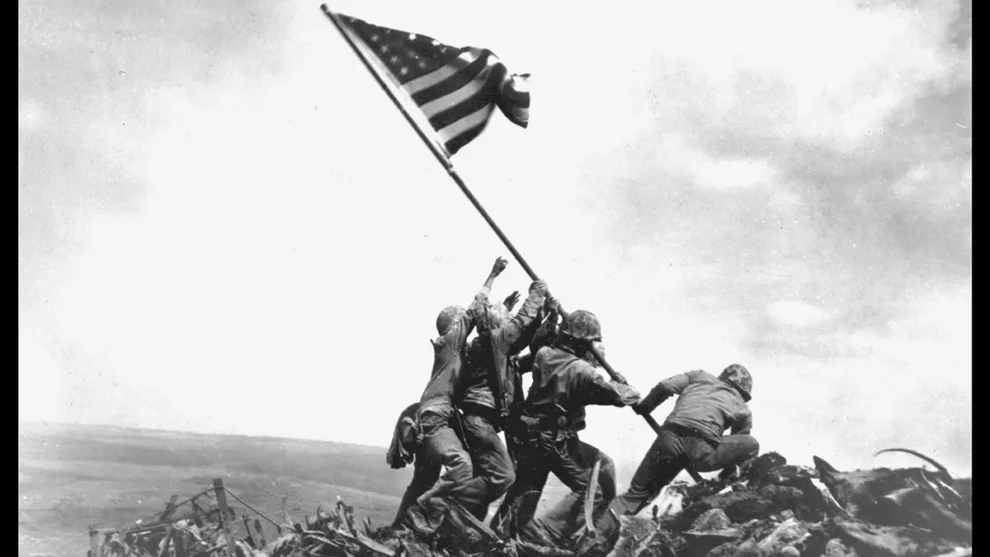Symbol of American boys raising Stars and Stripes amid deadly battle gripped the nation
Six United States Marines raised the American flag atop Mount Suribachi amid horrific combat on Iwo Jima, the intense wartime scene captured in perfect angle and frame by photographer Joseph Rosenthal, on this day in history, Feb. 23, 1945.
The raw power of the image instantly gripped a nation at war with Nazi Germany in Europe and imperial Japan in the Pacific — young American fighting men unfurling the Stars and Stripes on a remote island far from home in World War II.
Its power endures today.
“The flag raising became a symbol synonymous with American victory in World War II and what the nation can accomplish when we all pull together and unite for a just cause,” Owen Connor, senior curator of the National Museum of the Marine Corps, told Fox News Digital
The photograph hit the front page of almost every newspaper in the United States within days.
It’s been duplicated and admired endlessly through the decades and endures as the most powerful image of heroism in American history.
The Marines in the photo represent a broad cross-section of the American people.
"The photo became in many ways one of the first media events of the 20th century." — Owen Connor, National Museum of the Marine CorpsThe latest research indicates that the men are, from left: Pfc. Ira Hayes, 22, a book-loving Pima native from Sacaton, Arizona; Pfc. Harold Schultz, 20, of Detroit, who lied about his age to join the Corps after Pearl Harbor; Sgt. Michael Strank, 25, born in what’s now Slovakia and raised in Franklin Borough, Pennsylvania; Pfc. Franklin Sousley, 19, a factory worker from Hill Top, Kentucky; Harold Keller, 23, a telephone lineman from Brooklyn, Iowa; and Cpl. Harlon Block, 20, a star high school football player from Weslaco, Texas.
Block, Sousley and Strank were all killed on Iwo Jima, a volcanic island about 700 miles south of Tokyo.
The Marines invaded Iwo Jima on Feb. 19, its capture deemed essential to tightening the noose around the Japanese homeland.
“It took four days for the Marines to reach the summit of Suribachi,” the Department of Defense reports.
“The taking of the 554-foot hill was significant, in that it suppressed the fires from Japanese who were dug in and who had prime vantage of much of the island.”
The fighting continued until March 26.
Iwo Jima is considered by many historians the greatest battle in Marine Corps history.
About 27,000 Marines and sailors were killed or wounded in a month of combat.
Almost all 21,000 Japanese defenders, fighting from entrenched caves, tunnels and pillboxes, were killed; only 216 were taken prisoner.
Twenty-seven Marines and Navy Corpsmen earned the Medal of Honor on Iwo Jima, more than any other battle in U.S. history, according to the National World War II Museum.
“Uncommon valor was a common virtue,” Admiral Chester W. Nimitz, who commanded the Navy war effort in the Pacific, said of Iwo Jima.
"Uncommon valor was a common virtue." — Admiral Chester W. Nimitz“The photo became in many ways one of the first media events of the 20th century,” said Connor.
“Due to the speed in which the image went from the battlefield to Sunday newspapers in the United States (48 hours), it took on even greater meaning to a nation.”
The federal government immediately seized on the power of the photo to aid the war effort.
“The photo was the centerpiece of a war-bond poster that helped raise $26 billion in 1945,” the Pulitzer Prize Board writes in its online account of the image.
“On July 11, before the war had ended, it appeared on a United States postage stamp. Nine years later it became the model for the Marine Corps War Memorial in Arlington, Virginia.”
“The photo was the centerpiece of a war-bond poster that helped raise $26 billion in 1945,” the Pulitzer Prize Board writes in its online account of the image.
“On July 11, before the war had ended, it appeared on a United States postage stamp. Nine years later it became the model for the Marine Corps War Memorial in Arlington, Virginia.”
The raising of Old Glory far from home amid the savagery of global war represents the terrible human struggle to end the tyranny and slavery that ruled the world in the 1940s — for which the American people and their Allies fought to end in World War II at a terrible human cost.
The identity of the men in the photo has been a source of considerable controversy in recent years. The confusion was caused by numerous factors.
Navy Corpsman John Bradley was one of the men long identified as a flag raiser.
His son James Bradley wrote the powerful 2000 history of Iwo Jima, “Flags of Our Fathers,” an intense look at the horror of Iwo Jima and the lives of the men in the photo.
It was learned in recent years that Corpsman Bradley was not among the six men in the photo.
He remains no less a hero.
The book written by his grateful son stands as one of the best ever written on the brutality of war and the cost paid by the men who fought and died in World War II.
“Their collective image,” Bradley writes in the book of the boys in the photos, “blurred and indistinct yet unforgettable, became the most recognized, the most reproduced, in the history of photography.”
He added, “The flag-raising on Iwo Jima became a symbol of the island, the mountain, the battle; of World War II; the highest ideals of the nation, of valor incarnate.”
Source: Fox News















